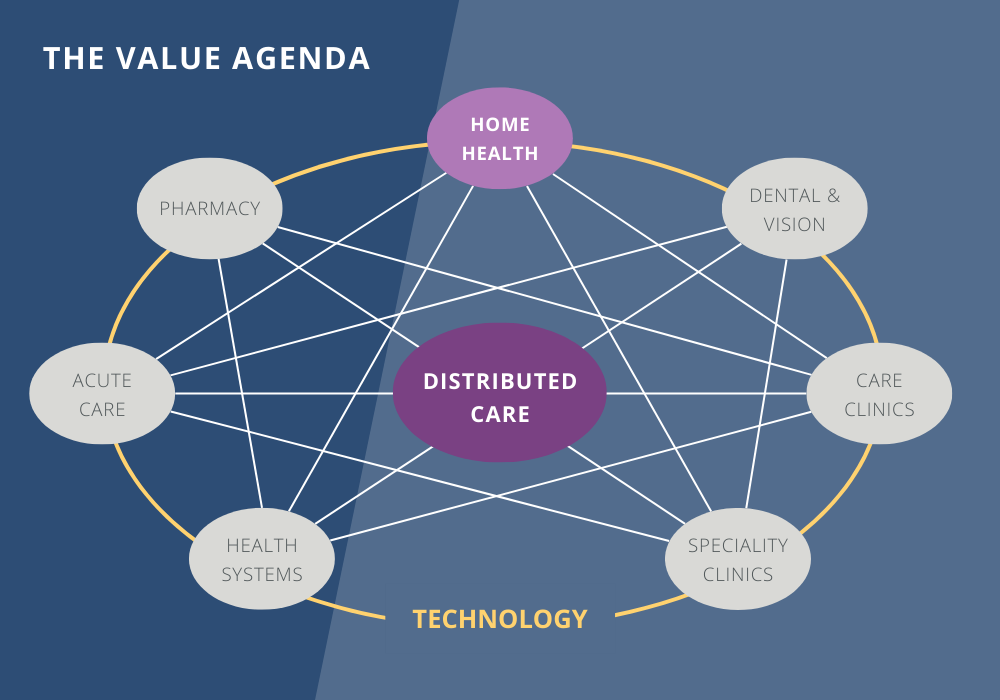HealthcareAI
The AI arms race in healthcare: Innovation without compromise
There are several key factors that healthcare organizations should consider when it comes to keeping up with the race…
Read article

Healthcare Optimize Technology
11/16/2022
by Alex Hill

The Value Agenda advocates for the shift from volume-driven goals to patient outcome-driven measures of success in healthcare. With consumers now in the driver’s seat, providers are looking for ways to satisfy patients while also caring for their employees. Enabling home health care is one of the popular places for providers to start. However, home-based health paired with distributed care is the optimal combination to achieve satisfied customers and foster a mentally healthy and loyal workforce.
Home-based primary care—or the modern-day “house call”—delivers primary care to the most medically complex and homebound or home-limited patients. Traditionally, these patients have represented the most costly segment of the healthcare system.
The ability to deliver care directly to the patient’s bedside brings an element of compassion and respect to the caregivers while offering comfort, ease, and peace of mind to the family. To patients, it is a no-brainer—it is much preferred to have the option to dial home health providers rather than 911 in a time of need. Let’s take a look at other benefits of home health:
To optimize customer value, providers can’t stop at home health care alone. While convenience and comfort are valuable, there are still limitations related to access, cost, and nursing staff shortages. Additionally, we know that the need for hospitals, specialty clinics, and other treatment centers will never be obsolete.
With a comprehensive view of customer care in mind, providers must consider offering a unified or integrated care experience by pairing home health with distributed care capabilities. For example, a recipient of home-based care might be someone who had surgery in a hospital but required post-op therapy, injections, or monitoring. The transition from the hospital to the comfort of the patient’s home requires coordination and strong communication; none of which would be available without distributed care networks.
Distributed care is a network that consists of all the locations in which medical units—including medical offices, clinics, treatment centers, and hospitals—are found and in which the delivery of medical services is carried out. Integration between facilities allows patients to receive consistent attention across geographic locations. At its best, this ecosystem offers both office visits and home health capabilities to cater to varying patient needs. Let’s take a look at acute care versus care management and the benefits of having distributed care capabilities to support both:
In either scenario, we can see that the value to the patient comes from the ability to receive care for their unique situation in a location that suits them, whether at home or in a physical building. To achieve this, Integrated Practice Units (IPUs) need to be established and equipped with the appropriate technical tools to integrate seamless care for patients across locations. By putting the right technology in the hands of the medical staff, you’re not only increasing the satisfaction of the patient, but you’re also equipping providers with a means to avoid frustration, increase access to relevant patient data, and avoid burnout if enabled effectively.
While both home health care and distributed care networks have independent value, health systems need to invest in both in order to truly move the needle toward achieving the Value Agenda.

The Value Agenda describes the shift to patient outcomes as being the main driver in healthcare. The six elements that make up the Value Agenda include:
This shift in focus is leading providers to reconsider how they deliver care. But how do you get started? Or, better yet, how do you ensure you’re successful? Start by identifying and enabling the right technology.
Technology is the key enabler for healthcare today. When caregivers deliver home-based care, they must be equipped with access to virtual medical records, portable labs, x-rays—the list goes on. Like much of our modern world, providers may also leverage their smartphones to further support this remote care model. Similarly, in a distributed care ecosystem, digital platforms must link the entire care team to each other and to the same repository of information.
There’s no one-size approach to selecting and implementing the right tools to support a healthcare ecosystem that leverages both home health and distributed care. Balancing patient outcomes, provider needs, and technical capabilities is another barrier that prevents health systems from realizing the full value of this modern care model. To learn more about what enabling this might look like for you, drop a line to one of our consultants.
Business insights
HealthcareAI
There are several key factors that healthcare organizations should consider when it comes to keeping up with the race…
Read article

Healthcare
While private equity investment in healthcare is valuable, providers should familiarize themselves with alternative…
Read article

HealthcareOptimize Technology
Advancements in health tech have allowed both patients and clinicians to experience the benefits of digital…
Read article
